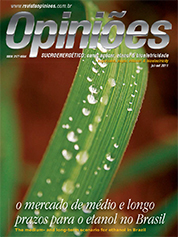Pedro Robério de Melo Nogueira
President of Sindaçúcar-AL
Op-AA-29
A very well defined scenario
The development of the national sugarcane-based energy industry in the last three decades has varied for different reasons or factors. At the onset, this was due to government inducement aimed at equipping the country to better face the needed reduction of oil imports that were consuming an increasingly larger share of our foreign payments flow at the beginning of the 1970’s.
Subsequently, in the 1990’s and until the end of the last century, development was dictated by the need to increase the consumer market that lagged behind supply, generating production surpluses that caused price reductions and discouraged activities.
Looking away from the rear mirror and out the windscreen to the medium- and long-term future, for the first time one sees a promising scenario resulting from the existence of a market, in the next ten years, that will absorb a quantity of ethanol twice the current one.
This is to say that we can grow from now on driven by demand that already exists and signals actual growth along the sustainable supply and demand curve of flex-fuel vehicles, the increase in demand for green ethanol in the chemical industry and the opening up of the foreign market represented by the intensive debate in the U.S. Congress about the reduction of barriers for the import of ethanol. To grow supply thanks to the market, or even to produce given a sure destination, is the maxim of any business venture.
For the national sugarcane-based energy industry, to see that in 2020 it will be inserted in a market twice the size of the current one is a finished symphony whose musical score entrepreneurs and investors will love to draw up. However, if it is a fact that the market is visible before us, it is not true that the conditions for this vigorous and needed increase in supply are defined and given.
The extraordinary growth until 2007, shrunken starting in 2008 and stagnant in terms of new projects at this time, will require actions and reflections more synchronized with the current reality, both in terms of availability of funds, disbursed under feasible conditions for such growth, and the assessment of a business’ profitability vis-à-vis the required investments.
The abundant availability of foreign funds in the first five years of the 2000 decade allowed almost doubling our sugarcane production based on new projects and the expansion of existing mills. The dry-up of the flow of funds, brought about by the 2007/2008 financial crisis, allows us to conclude that new flows will intimately be associated with an analysis of feasible returns in the production and marketing of ethanol in Brazil.
Thus, the investment flow of funds needed to reach 2020 with a balanced supply, given the current market, will necessarily require reflections and the taking into account of some relevant aspects:
- To reach a production of about 1.2 billion tons of sugarcane, one must begin with a bold renewal of the current sugarcane plantations that entail degraded areas of considerable size and low productivity, which, by the way, ought to be a permanent procedure to maintain adequate productivity.
A financing program for the renewal of sugarcane plantations and the implementation of new ones will not take place at the same speed as in 2007, given the new remote areas to be exploited, low celerity in licensing, interpretational difficulties in monitoring labor relations, the adequate flow in freeing funds for loans and the feasible cost of such loans when compared with the prices to be attained;
-
The investment environment must make it clear for entrepreneurs or investors that compensation and returns are stable, further considering the characteristics of ethanol as fuel originating in agriculture, with seasonal production and sensitive to unmanageable climate adversities;
-
As a product subject to the costs of market factors, to have available sustainability mechanisms when its price is limited by the outside imposition of the price of gasoline, which occasionally sustains a prolonged tolerance to practicing prices compatible with oil market prices;
-
The understanding that the domestic supply policy must result from adequate compensation, while also considering the needed build-up of seasonal inventory, even when taking into account some aspects of entrepreneurial commitment resulting from permanent and stable public policies in the industry;
- Precise understanding that revenues resulting from sugar exports in industrial units that produce sugar and ethanol is a factor in the formation of entrepreneurial thrift, which is important to supplement the flow of working capital required for ethanol production;
- To assess production capacity in the capital goods industry in view of supplying industrial equipment and machinery, as well as agricultural machinery needed for such expansion.
Hence, one may conclude that at this time there is in fact a medium- and long-term scenario for ethanol and the national sugarcane-based energy industry. Perhaps never before so well contrasted with the scenarios that preceded past expansions. However, growth in supply will not be feasible at the pace of the five years prior to 2008.
On the other hand, one should mention Brazilian expertise in the implementation and operation of biofuel projects, which, when combined with overcoming the above mentioned aspects, will allow us to definitively consolidate Brazilian ethanol production so as to participate in all markets.




